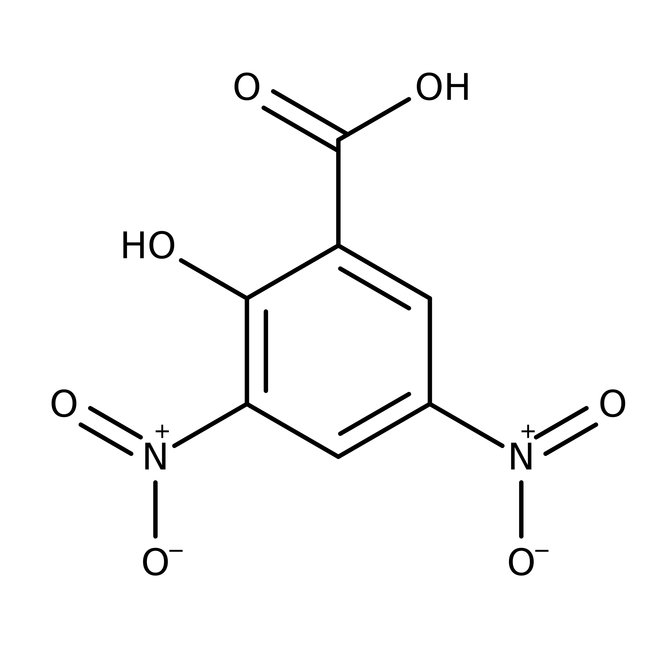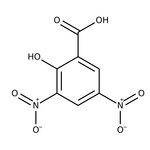Search Thermo Fisher Scientific
Thermo Scientific Chemicals
3,5-Dinitrosalicylic acid, 97+%
CAS: 609-99-4 | C7H4N2O7 | 228.116 g/mol
Catalog number ALFA16988.30
View Price:Sign InSign in to see your account pricing. Need an account? Register with us today.
Quantity:
250 g
Specifications
Chemical Name or Material3,5-Dinitrosalicylic acid
CAS609-99-4
Health Hazard 1H302-H315-H319-H335
Health Hazard 2GHS H Statement
H302-H315-H319-H335
Harmful if swallowed.
Causes skin irritation.
Causes serious eye irritation.
May cause respiratory irritation.
H302-H315-H319-H335
Harmful if swallowed.
Causes skin irritation.
Causes serious eye irritation.
May cause respiratory irritation.
Health Hazard 3P261-P264b-P270-P271-P280-P301+P312-P302+P352-P304+P340-P305+P351+P338-P312-P330-P332+P313-P362-P501c
View more
3,5-Dinitrosalicylic acid is used in the quantification of reducing sugars by colorimetry. It is utilized for the analysis of glycosidase (glycoside hydrolase) activity by quantitation of enzymatically released reducing sugar. It is also used to detect reducing substances in urine and for quantifying carbohydrate level in blood. It acts as an important raw material and an intermediate in the production of organic chemicals such as agrochemicals, organic synthesis, pharmaceuticals and dyes.
This Thermo Scientific Chemicals brand product was originally part of the Alfa Aesar product portfolio. Some documentation and label information may refer to the legacy brand. The original Alfa Aesar product / item code or SKU reference has not changed as a part of the brand transition to Thermo Scientific Chemicals.
Applications
3,5-Dinitrosalicylic acid is used in the quantification of reducing sugars by colorimetry. It is utilized for the analysis of glycosidase (glycoside hydrolase) activity by quantitation of enzymatically released reducing sugar. It is also used to detect reducing substances in urine and for quantifying carbohydrate level in blood. It acts as an important raw material and an intermediate in the production of organic chemicals such as agrochemicals, organic synthesis, pharmaceuticals and dyes.
Solubility
Soluble in water, dimethyl sulfoxide, methanol, ethanol, diethyl ether and benzene.
Notes
Incompatible with strong oxidizing agents, strong bases, strong reducing agents and strong acids.
3,5-Dinitrosalicylic acid is used in the quantification of reducing sugars by colorimetry. It is utilized for the analysis of glycosidase (glycoside hydrolase) activity by quantitation of enzymatically released reducing sugar. It is also used to detect reducing substances in urine and for quantifying carbohydrate level in blood. It acts as an important raw material and an intermediate in the production of organic chemicals such as agrochemicals, organic synthesis, pharmaceuticals and dyes.
Solubility
Soluble in water, dimethyl sulfoxide, methanol, ethanol, diethyl ether and benzene.
Notes
Incompatible with strong oxidizing agents, strong bases, strong reducing agents and strong acids.
RUO – Research Use Only
General References:
- Taipa, M. A.; Azevedo, A. M.; Grilo, A. L.; Couto, P. T.; Ferreira, F. A. G.; Fortuna, A. R. M.; Pinto, I. F.; Santos, R. M.; Santos, S. B. Student Collaboration in a Series of Integrated Experiments To Study Enzyme Reactor Modeling with Immobilized Cell-Based Invertase. J. Chem. Educ. 2015, 92 (7), 1238-1243.
- Garcia-Moscoso, J. L.; Teymouri, A.; Kumar, S. Kinetics of Peptides and Arginine Production from Microalgae (Scenedesmus sp.) by Flash Hydrolysis. Ind. Eng. Chem. Res. 2015, 54 (7), 2048-2058.



